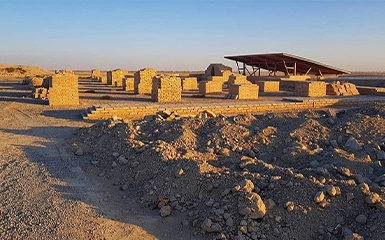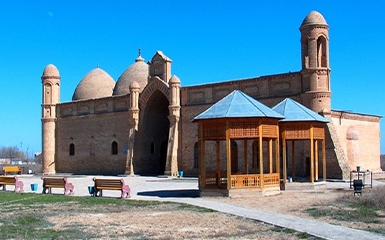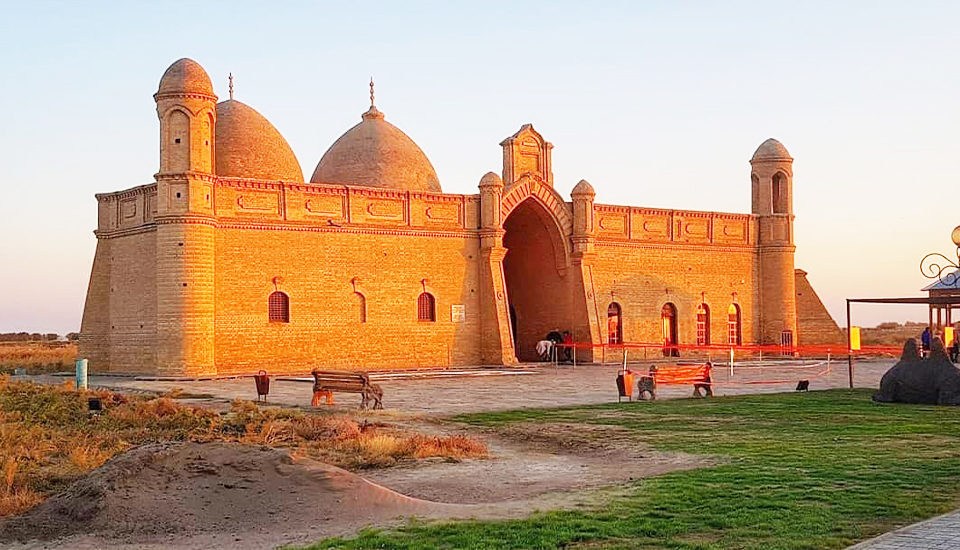Aisha-Bibi mausoleum
Aksu-Zhabagly
Aktau
Almaty
Altyn-Emel
Arystan Bab
Atyrau
Azret Sultan
Babaji Khatun
Bayanaul
Begazy necropolis
Beket-Ata Mosque
Almaty Lake
Lake Burabay
shakpak-ata-cave
Charyn Canyon
Hilvet mosque
Hodja Ahmad Yesevi
Holy Cave
Kaindy
Kapchagay
Karakhan mausoleum
Karkaraly
Kizhel Kensh
Kolsai Lakes
Korgalzhyn
Balkash lake
Lake Shaitankol
Jochi Khan
Karasai and Agyntai Batyr
Kozy Korpesh and Bayan Sulu
Mashkhur Zhussip Kopeyuly
Rabiga Sultan Begim
Kenty-Baba
Nomad Fortress
Nur-Sultan
Ruins of Otrar
Ruins of Sauran
Shopan-Ata
Shymbulak
Sultan-Epe
Tamgaly Gorge
Tamgaly-Tas
Alasha Khan
Torysh
Zhirensakal Peak
Built over the 12th-century tomb of Arystan Bab, the mausoleum dates back to the 14th century, but was rebuilt several times until the 18th century. In the 18th century, the previous mausoleum, destroyed by an earthquake, was replaced by a double-domed structure supported by two carved wooden columns. Most of the current structure was built in the first decade of the 20th century, with only carved wooden columns remaining from the original building.
Scientists believe that Arystan-Bab is a semi-legendary figure of Central Asian mythology. His original cult was associated with water sources and the forces of nature. In its subsequent development, it went through four stages.
At first, the image survived the influence of the Kakhtanite (South Arabian) tradition. In the resulting version of the myth, Arystan-Bab was a compatriot of the Prophet Hud, was of great height and lived for 340 years. He knew the basics of 33 religions and ended up preferring Islam.
Second stage, the period of influence of the Shiite sect of the Kaisanites made Arystan Baba a descendant of Imam Muhammad ibn al-Hanafiyah, the son of Imam Ali, and endowed him with the title of "Bab". For example, this version is adhered to by Musa Sairami, the author of the treatise “The History of the Kashgarian rulers” and a direct descendant of Arystan-Bab. According to the genealogy compiled by him, the saint is at the same time the uncle of his disciple Khoja Ahmed Yasawi.
In third, the Samarkand theologian Necmuddin al-Nasafi reports that a friend of the prophet Yahya ibn Nastur ar-Rumi lived in Farab in the 11th century. He was over 340 years old and quoted 14 hadiths directly from Muhammad. According to common legend, Arystan-Bab himself took rags and a date palm from the hand of the prophet and instructed (amanat) to deliver them to Sheikh Ibrahim's son, Hodja Ahmed, who was to be born in Sairam.
At the last stage, Arystan-Bab becomes the mentor of Khoja Ahmed Yasawi, the founder of the influential Sufi tariqa Yasaviy. According to one version, the saint was the eldest of the sheikhs of the city of Yasy and became the first teacher for the young Ahmed, who later continued his education with Yusuf Hamadani in Bukhara.
He was buried in the mausoleum of the same name in the city of Otrar. A visit to the mausoleum and spending the night at the grave of Arystan-Bab is one of the main stages in the pilgrimage (ziyarat) to the mausoleum of Ahmed Yasavi in the city of Turkestan. Two more holy places with his name are known: one in the Bazar-Korgon region of the Jalal-Abad region of Kyrgyzstan (in 2003 a genealogy document was found there, issued to the direct descendants of Arystan-Bab), and the other in the lower reaches of the Syr Darya.


